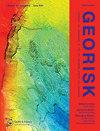Non-Stationary Flood Discharge Frequency Analysis in West Africa
IF 4.8
3区 工程技术
Q1 ENGINEERING, GEOLOGICAL
Georisk-Assessment and Management of Risk for Engineered Systems and Geohazards
Pub Date : 2023-08-11
DOI:10.3390/geohazards4030018
引用次数: 1
Abstract
With climate change and intensification of the hydrological cycle, the stationarity of hydrological variables is becoming questionable, requiring appropriate flood assessment models. Frequency analysis is widely used for flood forecasting. This study aims to determine the most suitable models (stationary and non-stationary) for estimating the maximum flows observed at some stations spread across West Africa. A statistical analysis of the annual maximum flows in terms of homogeneity, stationarity, and independence was carried out through the Pettitt, modified Mann–Kendall, and Wald–Wolfowitz tests, respectively, to identify the stations whose flows are non-stationary. After that, the best-correlated climate covariates with the annual maximum flows of the non-stationary stations were determined. The covariates explored are the climatic indices of sea surface temperatures (SST). Finally, different non-stationary GEV models were derived by varying the scale and position parameters of the best-correlated index for each station. The results indicate that 56% of the annual maximum flow series are non-stationary. As per the Bayes information criterion (BIC) values, the performance of the non-stationary models (GEV, generalized extreme values) is largely greater than that of the stationary models. These good performances of non-stationary models using climatic indices open perspectives for the prediction of extreme flows in the study area.西非非平稳洪水流量频率分析
随着气候变化和水文循环的加剧,水文变量的平稳性受到质疑,需要适当的洪水评估模型。频率分析被广泛应用于洪水预报。这项研究的目的是确定最合适的模型(平稳和非平稳)来估计在西非分布的一些站点观测到的最大流量。通过Pettitt检验、修正Mann-Kendall检验和Wald-Wolfowitz检验分别对年最大流量的同质性、平稳性和独立性进行统计分析,以确定流量是非平稳的站点。在此基础上,确定了与非平稳站年最大流量相关性最好的气候协变量。研究的协变量是海温(SST)的气候指数。最后,通过改变各站点最佳相关指标的尺度和位置参数,推导出不同的非平稳GEV模型。结果表明,年最大流量序列中有56%是非平稳的。根据贝叶斯信息准则(BIC)值,非平稳模型(GEV,广义极值)的性能大大优于平稳模型。使用气候指数的非平稳模型的这些良好性能为研究区极端流量的预测开辟了前景。
本文章由计算机程序翻译,如有差异,请以英文原文为准。
求助全文
约1分钟内获得全文
求助全文
来源期刊
CiteScore
8.70
自引率
10.40%
发文量
31
期刊介绍:
Georisk covers many diversified but interlinked areas of active research and practice, such as geohazards (earthquakes, landslides, avalanches, rockfalls, tsunamis, etc.), safety of engineered systems (dams, buildings, offshore structures, lifelines, etc.), environmental risk, seismic risk, reliability-based design and code calibration, geostatistics, decision analyses, structural reliability, maintenance and life cycle performance, risk and vulnerability, hazard mapping, loss assessment (economic, social, environmental, etc.), GIS databases, remote sensing, and many other related disciplines. The underlying theme is that uncertainties associated with geomaterials (soils, rocks), geologic processes, and possible subsequent treatments, are usually large and complex and these uncertainties play an indispensable role in the risk assessment and management of engineered and natural systems. Significant theoretical and practical challenges remain on quantifying these uncertainties and developing defensible risk management methodologies that are acceptable to decision makers and stakeholders. Many opportunities to leverage on the rapid advancement in Bayesian analysis, machine learning, artificial intelligence, and other data-driven methods also exist, which can greatly enhance our decision-making abilities. The basic goal of this international peer-reviewed journal is to provide a multi-disciplinary scientific forum for cross fertilization of ideas between interested parties working on various aspects of georisk to advance the state-of-the-art and the state-of-the-practice.

 求助内容:
求助内容: 应助结果提醒方式:
应助结果提醒方式:


